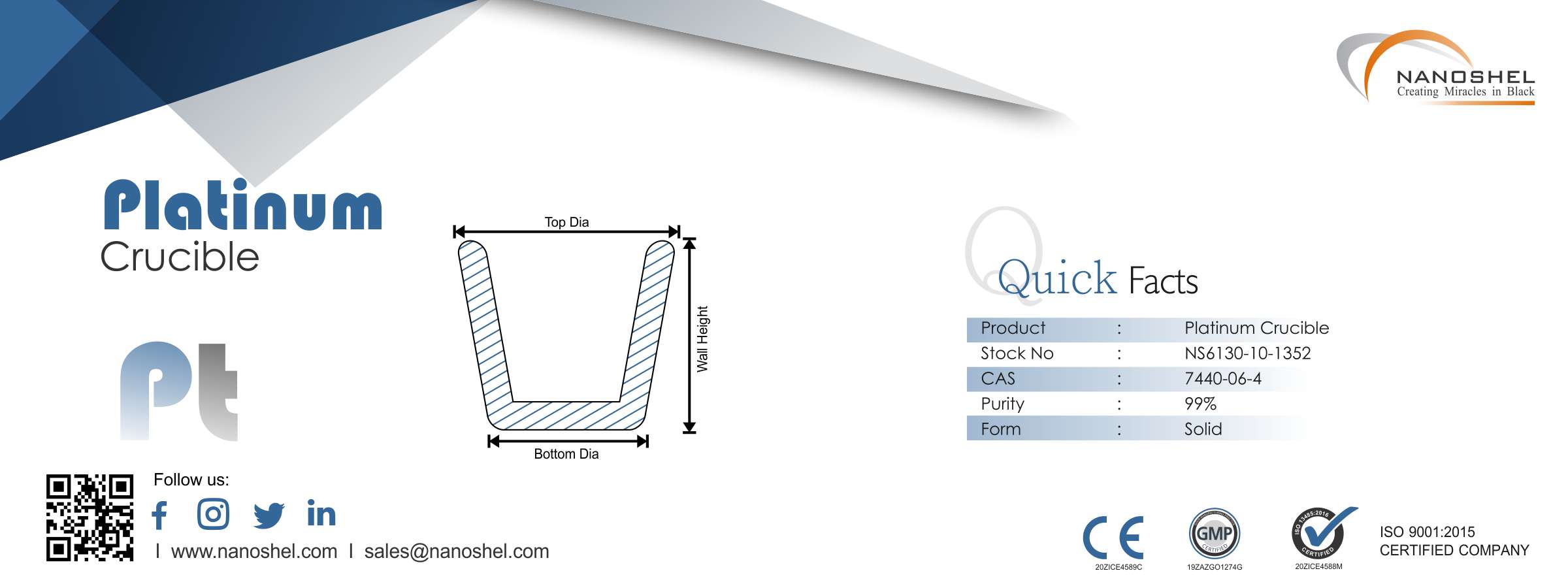Platinum Crucible
Pt, Purity: 99%, Capacity: 70ml
Platinum Crucible
Available Pack Size: 1Pc, 2Pcs, 5Pcs, 10Pcs & Bulk orders
| Product | Platinum Crucible | |
| Stock No. | NS6130-10-1352 | |
| CAS | 7440-06-4 | Confirm |
| Capacity | 70ml | Confirm |
| Top Diameter | 45mm | Confirm |
| Bottom Diameter | 40mm | Confirm |
| Height | 42mm | Confirm |
| Wall Thickness | 2mm | Confirm |
| Bottom Thickness | 2mm | Confirm |
| Molecular Formula | Pt | Confirm |
| Molecular Weight | 195.08g/mol | Confirm |
| Density | 21.45g/cm³ | Confirm |
| Melting Point | 1772°C | Confirm |
| Working Temperature | 1550°C | Confirm |
| Young’s Modulus | 168 GPa | Confirm |
| Thermal Conductivity | 0.716 W/cm/K @ 298.2 K | Confirm |
| Quality Control | Each Lot of was tested successfully | |
| Main Inspect Verifier | Manager QC | |
Expert Reviews
Platinum Crucible

Contact Us
From us, you can easily purchase Silver Nano particles as a new generation of Antimicrobials (Ag, Purity: 99.9%, APS: 50–80 nm, Metal basis) at great prices. Place an online order and we will dispatch your order through DHL, FedEx, UPS. You can also request a quote by mailing us at sales@nanoshel.com. We invite you to contact us for further information about our company and our capabilities. At Nanoshel, we look forward to your suggestions and feedback.
Email Us:
sales@nanoshel.comcmg@nanoshel.com
🔆
Follow Us:
Direct Call Us:
USA – Sales/Research
+1 646 470 4911
+1 646 470 4911
UK – Sales/Research
+44 1782 454 144
+44 1782 454 144
Ireland – Sales/Research
+354 71 985 3714
+354 71 985 3714
India – Sales/Research
+91-9779550077
+91-9779238252
+91-9779550077
+91-9779238252
Note:
*Exchanges of materials/products are not permitted. Nanoshel does not offer refunds.
*US Dollar Cheques Not Accepted, Only Bank TT/Credit Cards Accepted
*Exchanges of materials/products are not permitted. Nanoshel does not offer refunds.
*US Dollar Cheques Not Accepted, Only Bank TT/Credit Cards Accepted
